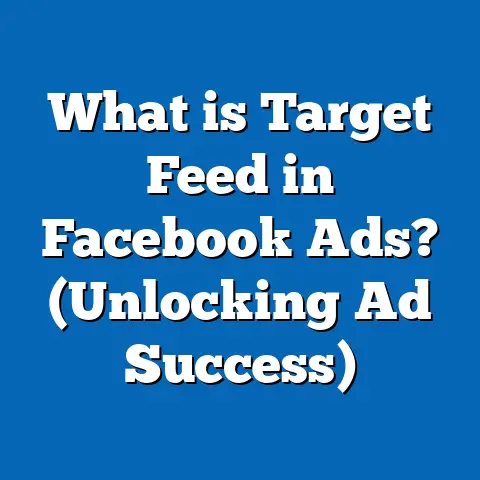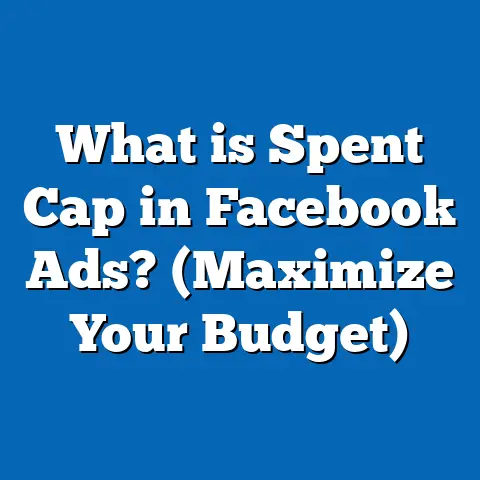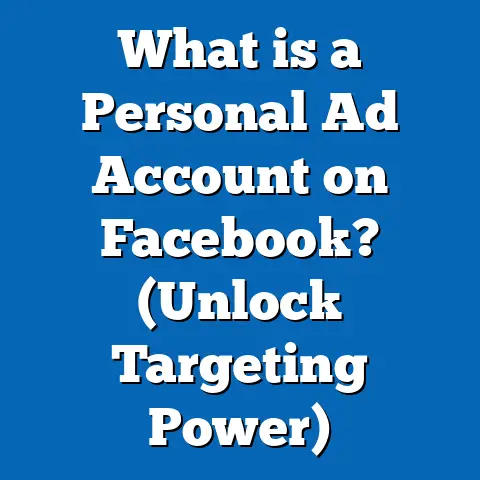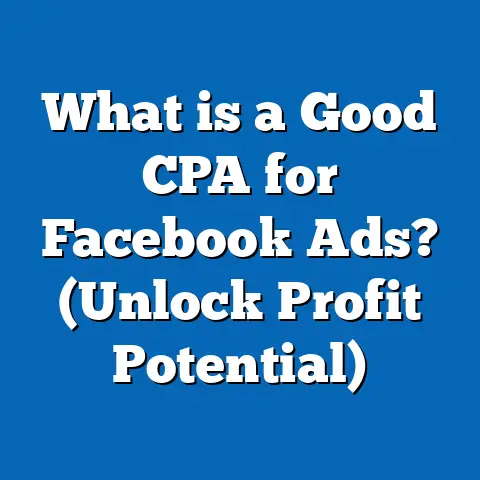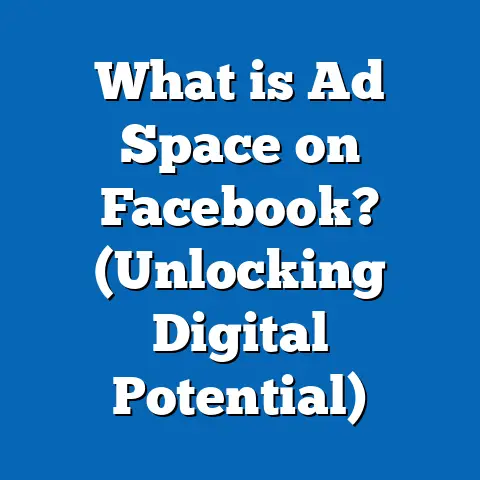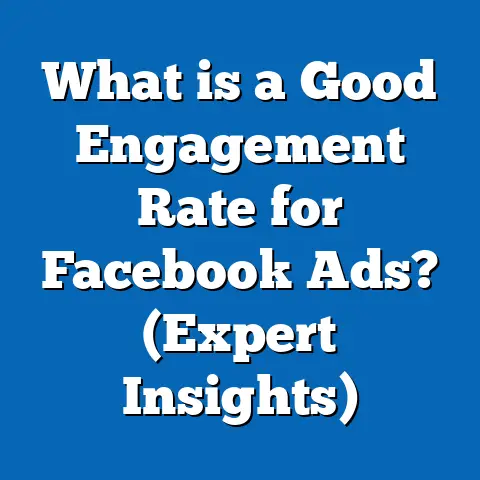What is a Small Budget for Facebook Ads? (Unlocking Limits)
Introduction: Understanding Budget Needs for Facebook Ads in Different Business Contexts
Every marketing environment has its unique requirements. Whether you are running a small local store, launching an online startup, or managing a niche B2B service, your advertising budget reflects your business scale and goals. Facebook advertising is a powerful tool because it allows highly targeted campaigns at various budget levels. However, many marketers and small business owners ask: What counts as a small budget for Facebook ads?
This question is critical because understanding the optimal spending level can help you avoid wasting money while still achieving meaningful results. With Facebook’s auction-based system and constant algorithm updates, there is no one-size-fits-all answer. Instead, it’s about knowing the limits of your budget and how to unlock its full potential.
This guide dives deep into what constitutes a small budget on Facebook, explains the mechanics behind ad spends, offers data-backed insights, explores practical case studies, and provides actionable strategies to maximize performance no matter how limited your budget is.
What Defines a Small Budget for Facebook Ads?
Understanding Facebook Ad Budgets: Minimums and Typical Ranges
Facebook Ads Manager allows advertisers to set daily or lifetime budgets for their campaigns. While technically you can spend as little as $1 per day per ad set, practical considerations make the minimum effective budget higher.
- Facebook’s Recommended Minimum: The platform suggests at least $1 per day per ad set to allow proper delivery and learning.
- Practical Minimum for Real Impact: Industry experts recommend starting with $5-$10 per day to gather enough data and reach.
- Small Budget Range: For many small businesses, a monthly ad spend between $100 and $500 is considered small.
- Micro-Budgets: Budgets below $100 monthly are rare but possible for very niche or hyper-local campaigns.
Why These Budget Levels Matter
- Ad Delivery & Learning: Facebook’s machine learning algorithm needs sufficient data volume to optimize ad delivery. With too little budget, campaigns remain stuck in the learning phase.
- Audience Reach: The budget affects the size and frequency of your audience reach. Too low a budget may limit exposure and increase frequency too rapidly.
- Campaign Duration: Smaller budgets might require shorter campaigns or fewer ad variations.
- Competitive Landscape: In competitive industries, low budgets can make it difficult to win auctions consistently.
Data-Backed Insights on Small Budgets in Facebook Advertising
Average Costs & Industry Benchmarks
Facebook advertising costs vary significantly by industry, region, seasonality, and audience targeting. Understanding these costs helps set realistic expectations.
| Industry | Avg CPC (Cost Per Click) | Avg CPM (Cost Per 1000 Impressions) | Avg CTR (Click Through Rate) |
|---|---|---|---|
| Retail | $0.70 – $1.50 | $7 – $12 | 1.5% – 2.5% |
| Finance | $1.50 – $3.00 | $10 – $15 | 0.8% – 1.5% |
| E-commerce | $0.50 – $1.20 | $5 – $10 | 2.0% – 3.0% |
| Health & Wellness | $0.80 – $2.00 | $6 – $14 | 1.2% – 2.5% |
Spending Trends Among Small Businesses
According to recent data from AdEspresso’s 2023 Small Business Report:
- 60% of small businesses spend less than $500 per month on Facebook ads.
- About 30% spend between $100-$300 monthly, balancing budget constraints with growth goals.
- The most successful small-budget advertisers focus on niche targeting and creative testing.
Small Budget Performance: Key Findings from WordStream Study 2023
| Budget Range | Avg CPC | Conversion Rate | ROAS (Return on Ad Spend) |
|---|---|---|---|
| <$100 / month | $1.20 | 1.2% | 2.5x |
| $100 – $500 / month | $0.85 | 2.0% | 4.0x |
| >$500 / month | $0.65 | 3.0% | 5.5x |
The takeaway: smaller budgets often mean higher per-action costs but can still generate strong returns with proper targeting and optimization.
How Facebook’s Ad Auction Affects Small Budgets
Understanding the Auction System
Facebook Ads operate on an auction model where advertisers bid to show ads to specific audiences. The auction considers:
- Bid amount: How much you’re willing to pay per click or impression.
- Estimated action rates: The likelihood users will take the desired action.
- Ad quality & relevance: Higher quality ads get preference even at lower bids.
Challenges Small Budgets Face in the Auction
- With limited daily budgets, fewer bids are placed in auctions.
- Competing against larger advertisers with bigger budgets often means higher costs or less frequent ad delivery.
- Limited spend restricts Facebook’s ability to gather enough data to optimize effectively.
Strategies to Compete with Small Budgets in Auctions
- Narrow Audience Targeting: Focus on specific demographics or interests with less competition.
- Automatic Bidding: Let Facebook optimize bids within your budget constraints.
- High Relevance Scores: Create engaging ads that resonate with your audience to boost quality score.
- Dayparting: Schedule ads at times when competition may be lower and audience engagement is higher.
Breaking Down Budget Allocation: Where Does Your Money Go?
Understanding how your budget is spent can help allocate resources better.
Distribution of Budget Components
- Ad Delivery and Auction Costs: Approximately 70%-85% of your budget directly pays for impressions/clicks.
- Creative Production Costs: Though not part of Facebook spend directly, quality creatives require investment upfront.
- Management and Optimization Time: Time or agency fees spent on ongoing campaign management.
Example Breakdown for a $300 Monthly Budget
| Component | Approximate Cost |
|---|---|
| Ad Spend (Auction) | $270 |
| Creative Production | Variable (DIY or professional) |
| Management & Testing | Time invested by marketer |
Practical Case Studies: Small Budget Success Stories
Case Study 1: Local Coffee Shop – $150/Month Budget
Objective: Boost weekday foot traffic during slow hours.
- Targeted radius: 3 miles around shop location.
- Ad Format: Short video showcasing new seasonal drinks.
- Duration: 2 months.
Results:
- 20% lift in weekday visits tracked via POS.
- Increased social media engagement by 35%.
Lessons Learned:
- Hyper-local targeting maximizes budget efficiency.
- Video content increased engagement despite low spend.
Case Study 2: E-commerce Startup – $300/Month Budget
Objective: Drive sales for a new product line.
- Used carousel ads featuring product variations.
- Targeted lookalike audiences based on website visitors.
- Split-tested copy and images.
Results:
- Achieved ROAS of 4x in first month.
- Identified winning creative that drove over 60% of conversions.
Lessons Learned:
- Testing is crucial even with limited budgets.
- Lookalike audiences increase efficiency versus broad targeting.
Case Study 3: Non-Profit Organization – $100/Month Budget
Objective: Increase newsletter signups for awareness campaign.
- Used lead generation ads with simple form.
- Targeted interest groups related to cause.
Results:
- 150 new signups in one month.
- Cost per lead: approximately $0.66.
Lessons Learned:
- Lead ads simplify conversion process and reduce friction.
- Even micro-budgets can drive meaningful engagement when goals are clear.
Unlocking Limits: Maximizing Small Budgets on Facebook Ads
Campaign Structure Tips
- Limit Number of Ad Sets: Spreading a small budget across many ad sets reduces effectiveness.
- Focus on One Clear Objective: Avoid overlapping goals that dilute learning.
- Use Lifetime Budgets When Possible: Allows Facebook to optimize spending over the campaign duration.
Ad Creative Strategies for Small Budgets
- Focus on simple yet compelling visuals that convey your message quickly.
- Leverage user-generated content or testimonials to build trust affordably.
- Use concise copy emphasizing benefits and clear calls-to-action.
Optimization Tactics
- Monitor frequency closely; pause ads when frequency exceeds 3–4 to avoid fatigue.
- Pause underperforming ads after short testing periods (3–5 days).
- Use retargeting to convert warm audiences cost-effectively.
Leveraging Audience Types Effectively
| Audience Type | Use Case | Budget Efficiency |
|---|---|---|
| Core Audiences | Broad demographics and interests | Good for initial testing |
| Custom Audiences | Website visitors, email lists | High conversion potential |
| Lookalike Audiences | Similar users to best customers | Scalable with small budgets |
Comparing Facebook Ads Small Budget Strategies with Other Platforms
| Platform | Minimum Suggested Budget | Strengths for Small Budgets | Limitations |
|---|---|---|---|
| Facebook Ads | $5/day | Advanced targeting, diverse formats | Auction competition can be high |
| Google Ads | $10/day | High-intent keywords | CPC can be expensive in some niches |
| Instagram Ads | $5/day | Visual storytelling, younger audience | Limited text space |
| TikTok Ads | $20/day | Viral potential | Newer platform with evolving tools |
Facebook remains preferred for small budgets due to its precise targeting and multi-format options.
Advanced Concepts: Leveraging Facebook’s Latest Features for Small Budgets
Advantage+ Campaigns (Automated Campaigns)
Facebook’s Advantage+ campaigns automatically optimize across placements and audiences using machine learning.
- Best for advertisers with limited time or experience.
- Maximizes performance by dynamically adjusting targeting and bids within your set budget.
Conversions API (CAPI)
Improves conversion tracking accuracy by sending data directly from your server to Facebook, bypassing browser limitations like cookie restrictions.
- Especially valuable for small budgets as it enhances data quality essential for optimization.
Dynamic Creative Optimization (DCO)
Automatically combines multiple headlines, images, descriptions, and calls-to-action to find the best-performing combinations without manual split testing.
Deep Dive Into Metrics: What to Track on Small Budgets?
Tracking the right metrics is essential for making informed decisions:
| Metric | Why It Matters for Small Budgets |
|---|---|
| CTR (Click Through Rate) | Indicates ad relevance; low CTR suggests creative or targeting issues |
| CPC (Cost Per Click) | Helps measure cost efficiency; high CPC may require refinement |
| Conversion Rate | Measures how well clicks turn into desired actions |
| Frequency | High frequency can cause audience fatigue |
| ROAS (Return on Ad Spend) | Ultimate measure of profitability |
Small budgets require vigilant monitoring to avoid wasted spend quickly.
Practical Example: Step-by-Step Setup for a $200 Monthly Budget Campaign
- Define Clear Objective: E.g., Increase online sales via website purchases.
- Select Campaign Objective: Choose “Conversions” in Ads Manager.
- Set Daily Budget: Approximately $6.50/day ($200 divided by ~30 days).
- Audience Targeting: Use custom audiences (website visitors) plus lookalikes (1%-5%).
- Placements: Use Advantage+ placements (automatic) for best results.
- Ad Creative: Create three variations differing in image or copy.
- Launch Campaign: Monitor daily performance metrics (CTR, CPC).
- Optimize Weekly: Pause underperforming ads after at least 3 days; shift budget to best performers.
- Retarget Warm Audience: After initial week, retarget website visitors who didn’t convert.
- Analyze & Scale: If ROAS >3x, consider increasing budget gradually.
Tips for Staying Ahead with Small Budgets in an Evolving Platform
Keep Up with Algorithm Changes
Facebook frequently updates its algorithm affecting targeting and bidding strategies; staying informed is critical.
Use Automation Tools Wisely
Leverage tools like Advantage+ but monitor results closely as automation may not suit every niche.
Test Constantly but Smartly
Testing different creatives and audiences is vital but do so systematically to avoid wasting budget on too many variables simultaneously.
Prioritize Mobile-Friendly Creatives
Most Facebook users access via mobile devices; ads must load fast and display well on smaller screens.
Summary: Key Takeaways for Managing Small Budgets on Facebook Ads
- A small budget typically ranges from $100-$500/month but can be effective even below that with focus.
- Facebook’s auction-based system requires strategic audience targeting and high-quality creatives to succeed with small budgets.
- Data shows smaller budgets have higher CPCs but can still deliver good ROAS with optimization.
- Automation tools like Advantage+ campaigns help unlock more value from limited spend.
- Regular monitoring and quick adjustments prevent wasted ad dollars.
Next Steps: How To Start or Improve Your Small Budget Facebook Ads Today
- Identify your primary goal clearly (sales, leads, awareness).
- Set a realistic initial budget between $100-$300/month based on your capacity.
- Use detailed audience targeting focusing on custom and lookalike audiences.
- Create engaging ad creatives tailored for your target market.
- Launch campaigns with Advantage+ placements enabled for efficiency.
- Monitor key metrics daily during the first week; adjust quickly based on performance data.
- Use Dynamic Creative Optimization or manual A/B testing for continuous improvement.
- Consider integrating the Conversions API for better tracking accuracy.
- Scale gradually only when consistent positive ROAS is achieved.
If you want me to prepare templates for campaign setups or checklists tailored for small budgets on Facebook Ads, just let me know!
This guide aims to equip marketers and business owners with a thorough understanding of managing small-budget Facebook advertising campaigns successfully.

